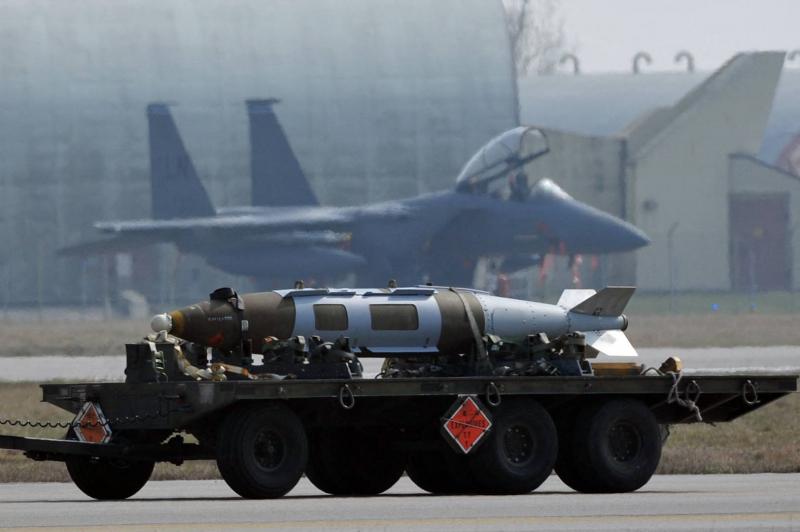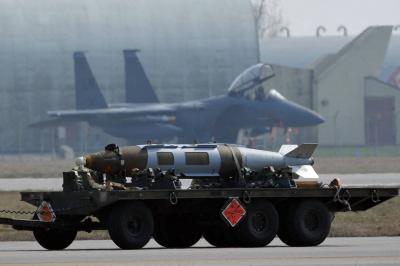The Economist magazine reviewed two books that addressed the risks of "annihilation" that our planet could face due to a nuclear attack. In one of them, the author refers to a "scenario" where the world could change within seconds as a result of the launch of a single missile. In her book "Nuclear War: A Scenario," American journalist Annie Jacobsen discusses a hypothetical nuclear attack launched by North Korea on the United States and the resulting "spiral" that could impact the world.
A summary of the book highlights a "vivid picture of what could happen if our nuclear guardians fail," suggesting that the world "as we know it could end within hours" due to "nuclear war." One cause of this war would be the launch of a nuclear missile towards the United States. The author based her assumptions on dozens of exclusive interviews with military and civilian experts connected to nuclear weapons development, those familiar with nuclear response plans, or involved in decision-making processes.
Several studies have previously reached alarming scenarios regarding what the world could look like in the event of a nuclear war, all agreeing on one point: the destruction of humanity. One of these studies concluded that any nuclear war could plunge the world into complete darkness for several years, causing a drastic drop in temperatures and wiping out much of the world's marine life.
The world fears nuclear war. A new study on the risks of nuclear war concluded that any conflict of this kind could engulf the world in total darkness for several years, significantly lower temperatures, and eradicate much of the marine life. Jacobsen notes the speed at which entire nations could be annihilated. She says that American satellites are equipped with sensors "powerful enough to see a lit match from 200 miles away." This means that within 15 seconds, radar can detect that a North Korean missile is headed towards the United States, which would take just over half an hour to reach its targets on American soil. Once the American president is informed, he has six minutes to make a decision.
She mentions that a Russian submarine off the West Coast of America can launch its entire array of missiles at all 50 states simultaneously within 80 seconds. In the scenario she imagines, a North Korean missile could destroy a nuclear power plant north of Los Angeles, while another bomb could obliterate the U.S. capital, Washington, D.C. A misunderstanding could arise during this hypothetical war between America and North Korea, as American missiles headed for North Korea would need to fly over Russia due to geography. American leaders might not be able to make a call to the Russian president, allowing Russian early warning satellites to mistakenly identify hundreds of incoming missiles, prompting the Kremlin to attack the United States, which would then retaliate.
Journalist Jacobsen quotes General John Hyten, former commander of U.S. nuclear forces: "If someone launches a nuclear weapon against us, we retaliate." William Perry, Secretary of Defense under former President Bill Clinton, states that once a missile is detected, "we prepare to launch... we don't wait." The magazine's report suggests that the ideas presented by the author might hold some flaws, questioning why North Korea would risk such a suicidal act and why the Russians would end the world based on faulty sensor data. However, what is undisputed, according to the magazine, is the transformative impact of nuclear weapons on the world. The presence of significant amounts of soot in the atmosphere following a nuclear attack could lead to a 70% reduction in sunlight for ten years and a 50% decrease in rainfall.
Jacobsen wrote: "After 10,000 years of agriculture and harvest, humans return to a state of hunting and gathering." In "Countdown," Sarah Skwire provides a glimpse into scientists in the vast American nuclear laboratories, such as the Los Alamos laboratories in New Mexico, where Oppenheimer oversaw the invention and construction of the first nuclear bomb. After years of gathering field reports in the country's nuclear weapons laboratories, Skwire asks in her book: "Does possessing nuclear weapons keep us safe and prevent attacks and nuclear war?"
She points to the idea that someone might use them someday, noting that their use in today's world is just as crucial as it was during the Cold War. Some experts believe we may be as close to a nuclear disaster now as we were at the height of that conflict. The report reflects the positions of American nuclear complex workers between proponents and opponents of nuclear disarmament. Some champion the importance of nuclear deterrence, claiming that the number of fatalities from major wars has declined since the invention of the nuclear bomb. Others express opposition to nuclear weapons while insisting some must ensure that the existing arsenal remains safe and reliable. Still, others prefer to focus on the civilian applications of their research.
Is humanity facing an "existential threat"? Accelerating development of destructive technologies, continuous escalation of wars and nuclear threats, amid unprecedented climate changes on Earth, are factors that bring humanity closer to the "end of the world" than ever before. The Economist points out a resurgence of discussions about nuclear wars following the Russian invasion of Ukraine in February 2022 and the success of the film "Oppenheimer," which chronicles the biography and story of American scientist Robert Oppenheimer and his role in developing the atomic bomb. After the invasion, there were serious concerns about the safety of the Zaporizhia nuclear power plant, the largest in Europe, which was taken over by Kremlin forces. Since then, Moscow and Kyiv have exchanged accusations regarding the bombing of the plant amid unsuccessful international efforts to establish a demilitarized zone around it.
After the invasion, Putin announced the conscription of hundreds of thousands of Russians to fight in Ukraine, warning the West that Moscow would "use all available means" to defend itself, including nuclear weapons. In a speech in March 2018, the Russian president revealed five major nuclear weapon programs, dubbed "superweapons," capable of reaching over 5,000 kilometers from their launch point using strategic Russian missiles, and capable of causing significant destruction. Russia possesses nearly 5,977 nuclear weapons that can be launched from missiles, submarines, and aircraft. In 2021, it spent an estimated $8.6 billion to build and maintain its nuclear forces, according to the ICANW, an organization dedicated to combating nuclear weapons.
A recent report by CNN revealed that by late 2022, the United States began "seriously preparing" for the possibility of Russia launching a nuclear strike on Ukraine. U.S. President Joe Biden has repeatedly warned Moscow against "using unconventional weapons."




